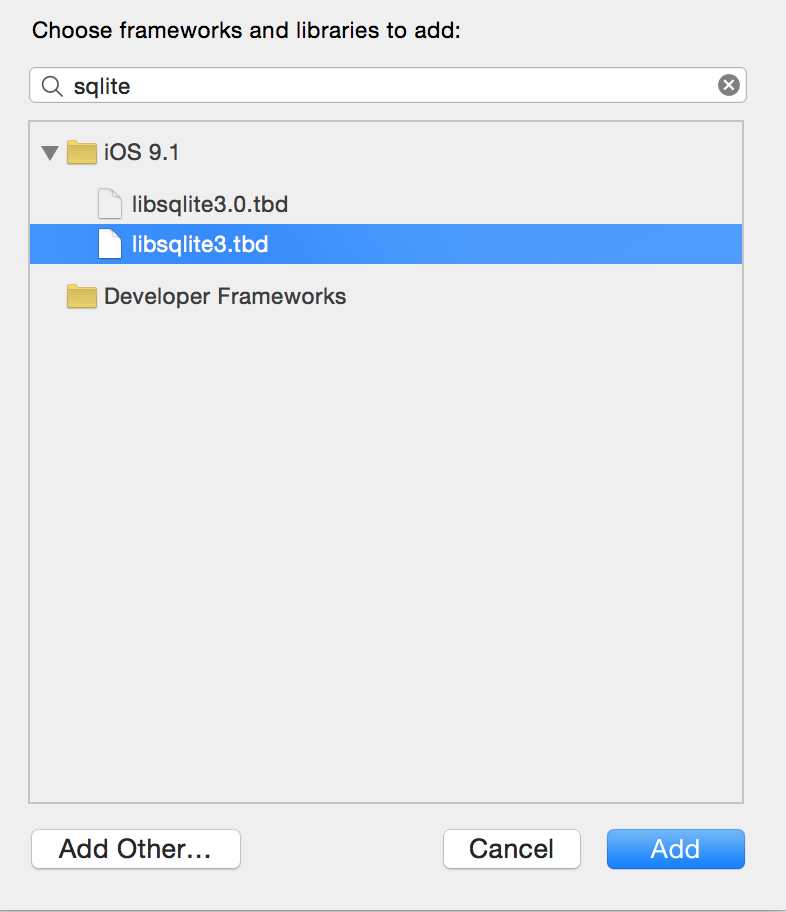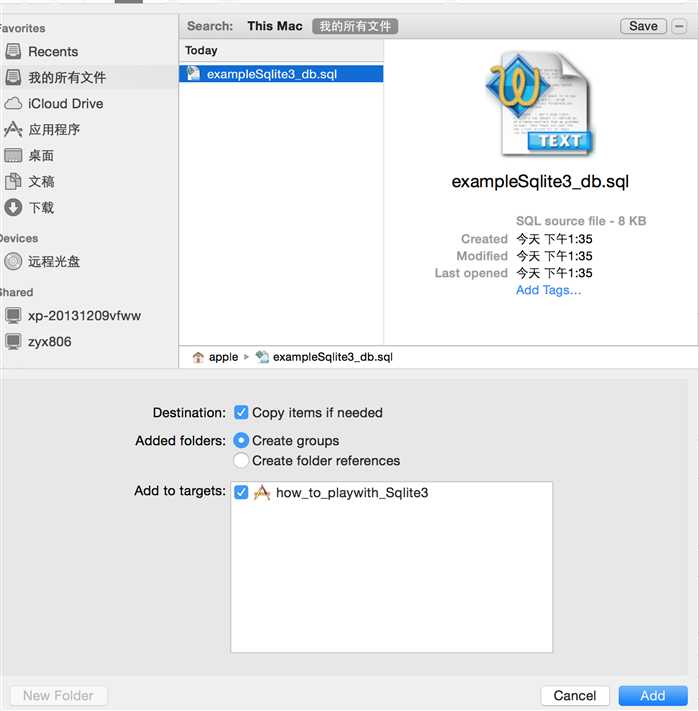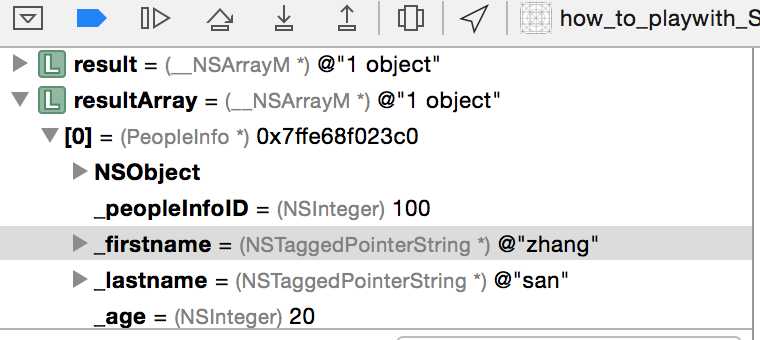标签:
1.简介
本文将介绍IOS的开发过程中如何集成Sqlite的方法,目前Sqlite的版本为3,所以我们称之为Sqlite3.
在本文中我将介绍Sqlite3的开发配置,本地Sqlite3数据库的建立通用的数据库访问类。
2.Sqlite3的开发环境配置
1.在工程中引入SQlite3开发库。
按照下图进行设定:


3.建立Sqlite数据库和表
1.打开终端窗口,输入如下命令:
172-11-253-106:~ apple$ sqlite3 exampleSqlite3_db.sql
SQLite version 3.8.5 2014-08-15 22:37:57
Enter ".help" for usage hints.
sqlite>
如上我们建立了一个名为exampleSqlite3_db的数据库。
2.建表
CREATE TABLE peopleInfo(peopleInfoID integer primary key, firstname text, lastname text, age integer);
表建立完毕后我们可以通过命令查询表是否建立成功:
sqlite> .tables peopleInfo sqlite>
随后退出:
sqlite> .quit 172-11-253-106:~ apple$
3. 至此本地所需要的数据库和表初始化完毕,将文件导入当前工程

4.至此本地数据库和数据库连接文件都已经创建完毕。
4.建立通用的数据库访问类
1.建立数据库model
#import <Foundation/Foundation.h> @interface PeopleInfo : NSObject @property(nonatomic, assign) NSInteger peopleInfoID; @property(nonatomic, strong) NSString * firstname; @property(nonatomic, strong) NSString * lastname; @property(nonatomic, assign) NSInteger age; @end
2.建立通用的Sqlite3访问类
.h文件
// // DBManager.h // how_to_playwith_Sqlite3 // // Created by apple on 15/12/14. // Copyright © 2015年 xufeng. All rights reserved. // #import <Foundation/Foundation.h> /** * Sqlite3访问类 */ @interface DBManager : NSObject /** * sql执行后受影响的行数,如delete、insert和update的时候可以以此判断数据库是否操作正常 */ @property (nonatomic) int affectedRows; /** * 记录最后一次的操作索引 */ @property (nonatomic) long long lastInsertedRowID; /** * 加载数据库文件 * * @param dbFilename 沙盘中的数据库文件 * * @return 数据库操作handler */ -(instancetype)initWithDatabaseFilename:(NSString *)dbFilename; /** * 执行查询操作 * * @param query 查询语句 * * @return 查询结果 */ -(NSArray *)loadDataFromDB:(NSString *)query; /** * 执行增删和更新的语句 * * @param query 执行语句 */ -(void)executeQuery:(NSString *)query; @end
.m文件
// // DBManager.m // how_to_playwith_Sqlite3 // // Created by apple on 15/12/14. // Copyright © 2015年 apple. All rights reserved. // #import "DBManager.h" #import <sqlite3.h> @interface DBManager() /** * 应用的Documents Directory */ @property (nonatomic, strong) NSString *documentsDirectory; /** * 数据库文件 */ @property (nonatomic, strong) NSString *databaseFilename; /** * 结果数组 */ @property (nonatomic, strong) NSMutableArray *arrResults; /** * 将bundle中的文件拷贝到Documents Directory */ -(void)copyDatabaseIntoDocumentsDirectory; /** * 执行SQLite语句 * * @param query SQLite语句 * @param queryExecutable 查询还是修改 */ -(void)runQuery:(const char *)query isQueryExecutable:(BOOL)queryExecutable; @end @implementation DBManager -(instancetype)initWithDatabaseFilename:(NSString *)dbFilename{ self = [super init]; if (self) { // 查找Documents Directory路径 NSArray *paths = NSSearchPathForDirectoriesInDomains(NSDocumentDirectory, NSUserDomainMask, YES); self.documentsDirectory = [paths objectAtIndex:0]; // 保存传入的数据库文件 self.databaseFilename = dbFilename; // 将bundle中的文件拷贝到Documents Directory [self copyDatabaseIntoDocumentsDirectory]; } return self; } -(void)copyDatabaseIntoDocumentsDirectory{ // 查询数据库文件是否在ocuments Directory已经存在? NSString *destinationPath = [self.documentsDirectory stringByAppendingPathComponent:self.databaseFilename]; if (![[NSFileManager defaultManager] fileExistsAtPath:destinationPath]) { // 如果不不存在则从bundle中将数据库文件拷贝到Documents Directory NSString *sourcePath = [[[NSBundle mainBundle] resourcePath] stringByAppendingPathComponent:self.databaseFilename]; NSError *error; [[NSFileManager defaultManager] copyItemAtPath:sourcePath toPath:destinationPath error:&error]; // 查看是够有错误 if (error != nil) { NSLog(@"%@", [error localizedDescription]); } } } -(NSArray *)loadDataFromDB:(NSString *)query{ // 执行查询 [self runQuery:[query UTF8String] isQueryExecutable:NO]; // 返回查询结果 return (NSArray *)self.arrResults; } -(void)executeQuery:(NSString *)query{ // 执行修改操作 [self runQuery:[query UTF8String] isQueryExecutable:YES]; } -(void)runQuery:(const char *)query isQueryExecutable:(BOOL)queryExecutable { // 数据库连接变量 sqlite3 *sqlite3Database; // 设定数据库文件 NSString *databasePath = [self.documentsDirectory stringByAppendingPathComponent:self.databaseFilename]; // 重置结果容器 if (self.arrResults != nil) { [self.arrResults removeAllObjects]; self.arrResults = nil; } self.arrResults = [[NSMutableArray alloc] init]; // 打开数据库 int openDatabaseResult = sqlite3_open([databasePath UTF8String], &sqlite3Database); if(openDatabaseResult == SQLITE_OK) { // Declare a sqlite3_stmt object in which will be stored the query after having been compiled into a SQLite statement. sqlite3_stmt *compiledStatement; // Load all data from database to memory. int prepareStatementResult = sqlite3_prepare_v2(sqlite3Database, query, -1, &compiledStatement, NULL); if(prepareStatementResult == SQLITE_OK) { // Check if the query is non-executable. if (!queryExecutable){ // In this case data must be loaded from the database. // Declare an array to keep the data for each fetched row. NSMutableArray *arrDataRow; // Declare an array to keep the col name for each fetched row. NSMutableArray *arrColRow; // Loop through the results and add them to the results array row by row. while(sqlite3_step(compiledStatement) == SQLITE_ROW) { // Initialize the mutable array that will contain the data of a fetched row. arrDataRow = [[NSMutableArray alloc] init]; arrColRow = [[NSMutableArray alloc] init]; // Get the total number of columns. int totalColumns = sqlite3_column_count(compiledStatement); // Go through all columns and fetch each column data. for (int i=0; i<totalColumns; i++){ // Convert the column data to text (characters). char *dbDataAsChars = (char *)sqlite3_column_text(compiledStatement, i); char *dbColAsChars = (char *)sqlite3_column_name(compiledStatement, i); // If there are contents in the currenct column (field) then add them to the current row array. if (dbDataAsChars != NULL) { // Convert the characters to string. [arrDataRow addObject:[NSString stringWithUTF8String:dbDataAsChars]]; [arrColRow addObject:[NSString stringWithUTF8String:dbColAsChars]]; } } // Store each fetched data row in the results array, but first check if there is actually data. if (arrDataRow.count > 0) { // first of all, we should put them in dictionary [self.arrResults addObject:[NSDictionary dictionaryWithObjects:arrDataRow forKeys:arrColRow]]; } } } else { // This is the case of an executable query (insert, update, ...). // Execute the query. int executeQueryResults = sqlite3_step(compiledStatement); if (executeQueryResults == SQLITE_DONE) { // Keep the affected rows. self.affectedRows = sqlite3_changes(sqlite3Database); // Keep the last inserted row ID. self.lastInsertedRowID = sqlite3_last_insert_rowid(sqlite3Database); } else { // If could not execute the query show the error message on the debugger. NSLog(@"DB Error: %s", sqlite3_errmsg(sqlite3Database)); } } } else { // In the database cannot be opened then show the error message on the debugger. NSLog(@"%s", sqlite3_errmsg(sqlite3Database)); } // Release the compiled statement from memory. sqlite3_finalize(compiledStatement); } // Close the database. sqlite3_close(sqlite3Database); } @end
3. 测试(先插入后查询)
插入如下测试语句:
- (void)viewDidLoad { [super viewDidLoad]; // Do any additional setup after loading the view, typically from a nib. // 数据库客户端操作-打开 DBManager *dbm = [[DBManager alloc] initWithDatabaseFilename:@"exampleSqlite3_db.sql"]; // 数据库客户端操作-插入s [dbm executeQuery:@"insert into peopleInfo values(100,‘zhang‘,‘san‘,20)"]; if (1 != dbm.affectedRows) { NSLog(@"%@", @"error happend!"); } else{ // 数据库客户端操作-查询 NSArray *result = [dbm loadDataFromDB:@"select * from peopleInfo"]; // 每行既是一个item,将其转化为具体的对象 PeopleInfo *peopleInfo = nil; NSMutableArray *resultArray = [[NSMutableArray alloc] init]; for (NSDictionary *rowDict in result) { peopleInfo = [[PeopleInfo alloc] init]; // 使用方法的时候必须model的属性名称和字典的key要保持完全一致 [peopleInfo setValuesForKeysWithDictionary:rowDict]; [resultArray addObject:peopleInfo]; } NSLog(@"%@", resultArray); } }
结果:

至此Sqlite3的集成方法介绍完毕。
标签:
原文地址:http://www.cnblogs.com/ios123/p/5045080.html